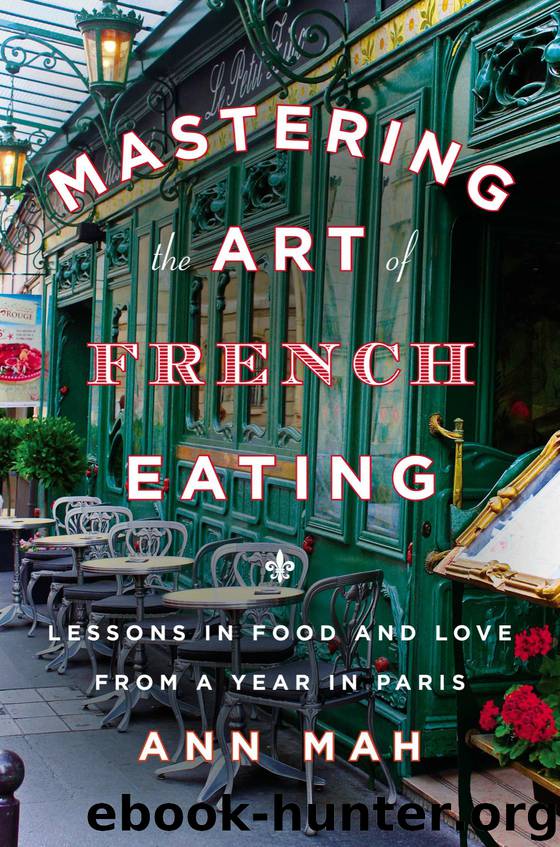Mastering the Art of French Eating : Lessons in Food and Love from a Year in Paris (9781101638156) by Mah Ann

Author:Mah, Ann
Language: eng
Format: epub
Publisher: Penguin USA
Published: 2013-08-23T04:00:00+00:00
Was this last point hubris or heresy? There was only one way to find out. I got in the car and headed east for Carcassonne.
* * *
The landscape between Castelnaudary and Carcassonne stretches dusty and flat, farmland baked dry by the generous sun that spills over the region. From the highway I saw the occasional hill town rising in the distance, left over from the Middle Ages when villages were built on high ground to help prevent attack. Between the eleventh and thirteenth centuries, the Cathars flourished in this region. A sect of Christianity descended from the Byzantine Empire, they embraced a rigid doctrine—forbidding meat and requiring celibacy. Cathars found tolerance in the Languedoc, constructing châteaus and citadels, amassing adherents—called “les Bons Hommes”—and weapons. They became such a concern to the Catholic Church that in 1207 Pope Innocent III dispatched a mission of papal legates to the region to slow their activities. When one of the envoys was assassinated, it was all the proof that Innocent needed to launch a religious crusade. The town of Carcassonne saw its share of blood during these wars, with a siege in 1209 that expelled the Cathars from its city walls. Decades of war and massacre followed, ending in a fiery inquisition that burned the remaining heretics alive. In 1321 the last Cathar was executed.
Today the old town still looks remarkably as it must have in the Middle Ages, perched on a hill, with turrets and moats and gap-toothed fortifications protecting a warren of steep cobblestone streets and thick stone buildings. Only a handful of residents live in the ville haute—as the upper section of Carcassonne is called. Rather it’s given over to museums, shops selling cheap tourist knickknacks, and restaurants advertising cassoulet. Even so, I thought I caught a glimpse of the wretchedness and wonder of medieval life as I moved from the chilled shadows of a side alley to the harsh light of the town square.
In a small hamlet a couple of miles from Carcassonne, I met Jean-Claude Rodriguez, the chef and owner of the restaurant Château Saint-Martin and the founder of the Académie Universelle du Cassoulet, an association devoted to the promotion and protection of cassoulet. Yes, there’s another one. And, as I soon discovered, while the Académie and the Grande Confrérie share a similar mission, they are bitter rivals.
Rodriguez founded the Académie in 2001, with the goal of “protecting the cassoulet made by restaurants with high-quality products from the region.” Its hundred members also wear robes—in red and white—medals, and hats that look like saggy chef’s toques, and they meet several times a year to taste cassoulet and judge them worthy of inclusion on their list. Sound familiar? Unlike the Grande Confrérie, however, the Académie has admitted chefs from other countries, such as Australia, the United States, and Japan.
These days very few chefs—even avid devotees like Rodriguez—prepare the traditional cassoulet of Carcassonne. “This used to be a country of vineyards, and in the vines we found partridges, wild hares, and other small game,” he said.
Download
This site does not store any files on its server. We only index and link to content provided by other sites. Please contact the content providers to delete copyright contents if any and email us, we'll remove relevant links or contents immediately.
Spell It Out by David Crystal(35847)
Underground: A Human History of the Worlds Beneath Our Feet by Will Hunt(11839)
A Year in the Merde by Stephen Clarke(5078)
Venice by Jan Morris(2431)
Claridge's: The Cookbook by Nail Martyn & Erickson Meredith(2257)
My Paris Kitchen: Recipes and Stories by Lebovitz David(2134)
A TIME OF GIFTS by Patrick Leigh Fermor(2101)
The Plantagenets by Dan Jones(1933)
Welcome to the Goddamn Ice Cube by Blair Braverman(1886)
Bang Poland: How To Make Love With Polish Girls In Poland by Roosh V(1857)
Top 10 Prague (EYEWITNESS TOP 10 TRAVEL GUIDES) by DK(1851)
The Finnish Way by Katja Pantzar(1811)
The Isle of Mull by Terry Marsh(1803)
From Russia with Lunch by David Smiedt(1795)
A TIME TO KEEP SILENCE by Patrick Leigh Fermor(1773)
Rick Steves London 2018 by Rick Steves & Gene Openshaw(1751)
A Taste of Paris by David Downie(1746)
Merde in Europe by Stephen Clarke(1671)
Insight Guides Experience Tokyo by Insight Guides(1659)
